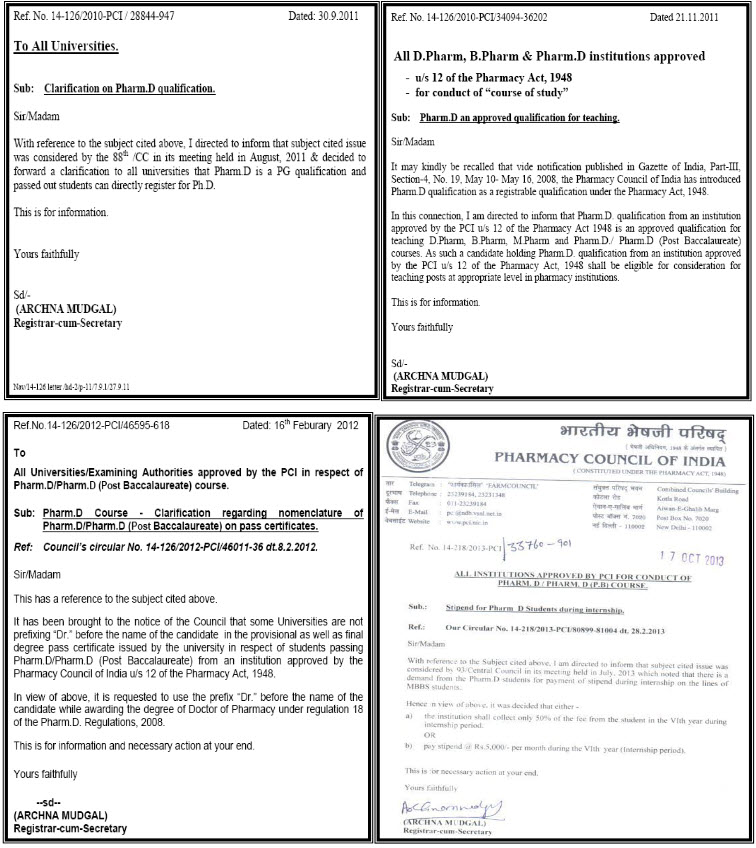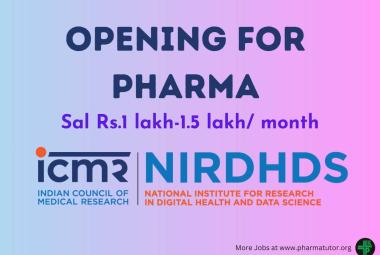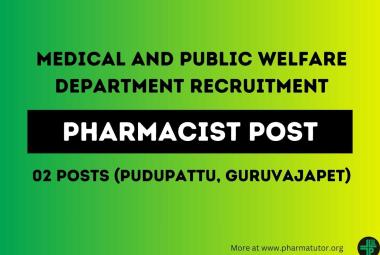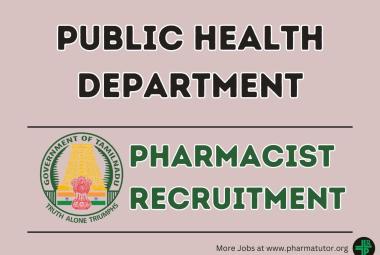{ DOWNLOAD AS PDF }
About Authors:
Gayathri Krishnamoorthy, Kanaka Durga Vadlapatla, Rini Susan Varghese, Britto Duraisingh*
Department of Pharmacy Practice,
PSG College of Pharmacy,
Coimbatore, Tamil Nadu
*brittopharmaco@gmail.com
Abstract:
The intention behind this piece of review work is to enable every single individual thoroughly understand this emerging field in Indian pharmacy that is Pharm.D, newly introduced in 2008 by the Pharmacy Council of India. It gives a direct doctorate degree after five years of college and one year internship in a hospital. This paper highlighted all the information regarding the prospectus of this field in India, colleges offering this course, scope, roles and responsibilities and feedback from student, intern and clinical pharmacist. Pharm.D is already well recognised in United States of America and majority of the gulf countries. Let’s look forward for an eye-opening future in India!!!!
Peek into the emerging field Pharm.D!
The Pharm.D course (6 year doctoral degree program in pharmacy) was introduced by the Pharmacy Council of India in 2008 aimed at improving patient care and providing pharmacy education programs. It is a pre-PhD, post-graduate program. It lays emphasis on all pharmacy practice components namely Clinical Pharmacy, Community Pharmacy, Clinical Research, Regulatory formulation development, Quality Control.
The mission of the profession is to improve public health through safe, effective and appropriate use of medications. Contemporary pharmacy practice reflects an evolving paradigm from the one in which the pharmacist primarily supervises medication distribution and counsel patients, to a more expanded and team-based clinical role providing patient- centered medication therapy management, health improvement, and disease prevention services.
Eligibility criteria:
For Pharm.D:
i) A pass in 10+2 examination with Physics and Chemistry as compulsory subjects along with one of the following subjects: Mathematics or Biology
ii) A pass in D.Pharm course from an institution approved by the Pharmacy council of India under section 12 of The Pharmacy Act.
For Pharm.D (Post Baccalaureate):
i) A pass in B.Pharm from an institution approved by the Pharmacy Council of India under section 12 of the Pharmacy Act.
The gazette:

Course structure:
The Pharm.D degree in India is available in 2 formats: a straight 6-year program after the completion of year12 in high school and a 3-year post baccalaureate degree program after completion of the traditional 4-year bachelor of pharmacy degree program. The Pharm.D degree requires five years of classroom-based didactic study (two years didactic post-baccalaureate course), followed by one year of internship training in addition to ongoing practicals and research project in any 500 bedded hospital or above.
The first batch of post-baccalaureate Pharm.D students graduated in August 2011.
Admission queries:
Number of admissions for the Pharm.D program shall be as prescribed by the Pharmacy Council of India from time to time and presently it is restricted to 30 candidates for Pharm.D and 10 candidates for Pharm.D. D (PB) per academic year.
Enrolment of various states and universities:
Initially, only a few pharmacy colleges in India offered the Pharm.D degree program after the PCI had given the go-ahead. In recent years, the number of colleges offering the Pharm.D degree has increased exponentially. Some of these colleges are afiliated with government universities while others are afiliated with private universities.
Total number of institutes offering both Pharm.D and Pharm.D (post baccalaureate) courses:
|
S.No |
State |
Number of colleges |
||
|
1 |
Andhra Pradesh |
55 |
||
|
2 |
Gujarat |
01 |
||
|
3 |
Haryana |
01 |
||
|
4 |
Karnataka |
28 |
||
|
5 |
Kerala |
11 |
||
|
6 |
Madhya Pradesh |
01 |
||
|
7 |
Maharashtra |
03 |
||
|
8 |
Punjab |
01 |
||
|
9 |
Tamil Nadu |
17 |
||
pci.nic.in/CollegesCourses/Baccalaureate.aspx
Roles and responsibilities of a qualified Pharm.D pharmacist:
|
S.No |
Role |
Description of Activity |
|
1. |
Drug Distribution and Dispensing |
Pharmacists assess legitimacy of prescriptions, eligibility for coverage, appropriateness and safety of the medication for the patient. |
|
2. |
Patient Safety |
Promote rational drug therapy by conducting drug utilization reviews, identifying potential prescription-related problems such as drug-drug interactions, duplication of drugs, known allergies, under or overdosing or inappropriate therapy, Prior authorization, Monitoring therapy, Pharmacokinetic dosing of drugs, Quality Assurance programs. |
|
3. |
Clinical Program Development |
Use evidence-based clinical and research data to create disease management programs. Evaluate scientific evidence in order to select appropriate drugs for a patient population through a Pharmacy and Therapeutics Committee Design and conduct outcomes based research in order to help patients achieve the desired results from their drug therapy. |
|
4. |
Communication with Patients, Prescribers and Pharmacists |
Helps prescribers choose drugs that will meet patient needs and qualify for coverage. Provide and educate patients about their individual prescription history. Provide a dispensing pharmacist with a patient’s drug profile in order to identify potential adverse drug reactions or duplicate therapies. |
|
5. |
Drug Benefit Design |
Determining if a formulary should be used, and whether it should be “restricted” or “open”; and the use of patient cost-sharing structure for generic, covered brand-name drugs and non-formulary drugs. To determine if a “participating” pharmacy network should be established and what the criteria for QA would be. To determine criteria and procedures for drug utilization. |
|
6. |
Business Management |
Negotiate with manufacturers for discounts on drug prices for clients in exchange for moving market share. Provide clients with customized clinical reporting that meet their population needs. |
|
7. |
Cost Management |
Encourage prescribers to make cost effective drug choices. Identify compliance and noncompliance with prescribing guidelines; assess physician performance; identify prescribing patterns that require improvement. |
Future:
The need for a mandatory national-level Pharm.D degree competency licensing examination:
While the PCI provides a uniform Pharm.D program syllabus for all pharmacy institutions in India to follow, the methods for evaluating competency of Pharm.D graduates differs across institutions. Amongst these institutions very few provide their students with a strong learning infrastructure and have their own hospitals to provide hands-on clinical training. So India needs a national level Pharm.D degree competency licensing examination which will enable all Pharm.D program graduates to practice pharmacy in India. This competency examination may be taken as soon as the student graduates with a Pharm.D degree before they register with the PCI. Passing this examination would then become mandatory for registration. There could be 2 parts to this proposed examination: theory and practical (clinical). The theory examination could be conducted by the PCI in the form of an online multiple-choice examination. The format of the licensing examination could be tailored along the lines of the NAPLEX examination with a suitable fee charged to each candidate taking it. The advantages and benefits of this system are manifold. It could provide uniform standards for Pharm.D program graduates from various universities. Modelling these examinations along the lines of the NAPLEX could provide equivalence between the Pharm.D degree earned in India and that earned in advanced pharmacy education nations like the United States, Canada, United Kingdom, Australia, etc. This would also go a long way in drastically improving the quality of the Pharm.D program in India.
Hence, a national level licensing examination would serve as the NAPLEX equivalent in India, which means that any foreign Pharm.D program graduate who decides to practice in India would be required to pass this examination.
Review desk:
As a Pharm.D-1st Year student, I strongly support this emerging course which is definitely going to embark a significant change in the upcoming years and will stand a bright chance in the field of professional practice in medicine. The profession of pharmacy is working to achieve a pervasive model and standard of care determined only by the needs of patients and populations. The evolutions in health care and pharmacy practice are presenting many new opportunities for pharmacists to perform functions and provide services not considered as traditional roles
There is limited understanding on part of the physicians, clinical staff and patients regarding the role of a clinical pharmacist. As a Pharm.D intern rotating through various care sites in a multi-speciality hospital, significant time was spent educating providers and clinical staff about the educational background, post graduate training which allows a pharmacist to operate in a unique role. But once they were comfortable with the pharmacist’s competence and clinical knowledge, he/she was allowed to have point of contact with the patient. The pharmacist is entrusted with medication therapy management, effective counselling, addressing patient barriers serving as a vital and complementary member of a multidisciplinary team.
As a practising clinical pharmacist, I wish to thank PCI panel for bringing such a wonderful course. Graduating from the second batch [2009 Pharm.D (PB)]; I invested most of my time introducing Pharm.D in the Indian clinical setting. I experienced a lot of hurdles while practising pharmacy, although i took them as constructive criticism. It definitely kick started my nurturing of skills: communication, dedication, interpersonal relationships, sound medical knowledge, and empathy towards patient. To all the budding pharmacist out there I would say “Be the change you want to see”
References:
1. Pharm.D Regulations 2008, Regulations framed under section 10 of the Pharmacy Act, 1 948 (8 of 1948): Available at: pci.nic.in/PDF-Files/PharmD-Revised-A.pdf. Accessed April 25, 2013.
2. Institutes offering Both Pharm.D and Pharm.D (Post Baccalaureate) in India: Available at: pci.nic.in/CollegesCourses/ Baccalaureate.aspx. Accessed April 25, 2013.
3. The NAPLEX, measures a candidate’s knowledge of the practice of pharmacy: Available at: nabp.net/programs/ examination/naplex/. Accessed April 25, 2013.
4. The Gazette information, policy and circulars: pci.nic.in/PolicyCirculars/Circulars.aspx
5. Scope of contemporary pharmacy practice: Roles, responsibilities, and functions of pharmacists and pharmacy technicians: japha.org/article
REFERENCE ID: PHARMATUTOR-ART-2144
|
PharmaTutor (ISSN: 2347 - 7881) Volume 2, Issue 4 Received On: 27/02/2014; Accepted On: 06/03/2014; Published On: 01/04/2014 How to cite this article: G Krishnamoorthy, KD Vadlapatla, RS Varghese, B Duraisingh, A Review on Pharm.D education in India, PharmaTutor, 2014, 2(4), 144-148 |
NOW YOU CAN ALSO PUBLISH YOUR ARTICLE ONLINE.
SUBMIT YOUR ARTICLE/PROJECT AT articles@pharmatutor.org
Subscribe to Pharmatutor Alerts by Email
FIND OUT MORE ARTICLES AT OUR DATABASE










